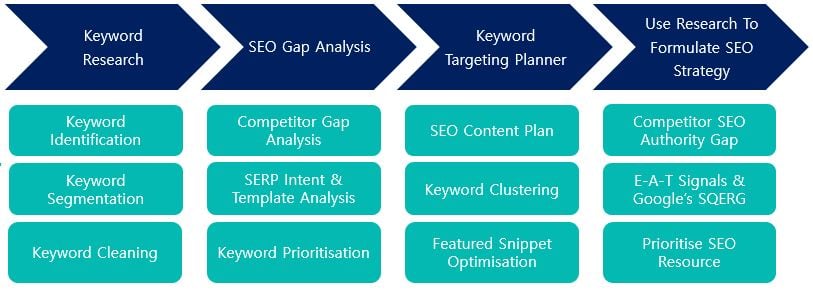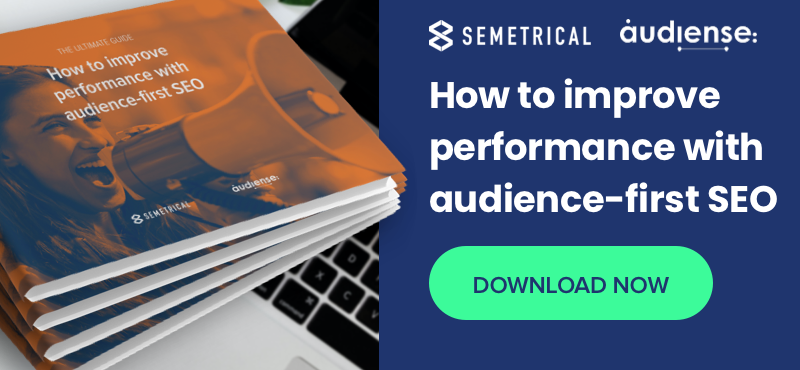How to integrate keyword and audience intelligence research
This is the first article in a series of guides that will focus on how you can integrate your keyword intelligence and audience intelligence that develops an audience-centric digital strategy that will improve SEO, paid media, content, digital PR, social media & email campaign metrics.
Audience-centric digital strategy is a means of marketing personalisation that aims to achieve a high level of customer satisfaction by tailored relevant, engaging and contextual experiences that delight customers.
Behavioural analytics must be at the core of your audience-centric digital strategy, and you need advanced technology to analyse the extensive amount of data available. At Semetrical, we believe one of the best tools for audience intelligence is Audiense, as it enables quick, insights-rich social consumer segments (referred to as ‘audience segments’) to be identified that can drive your strategy forward.
You should integrate this data with other data sources including:
- Google Ads Keyword Planner search data for keyword intelligence
- Pulsar for social listening to undertake your Audiense audience intelligence reports on keywords around topics and interests.
The objective is to connect the insights gathered from your keyword intelligence and audience intelligence research to establish an integrated digital strategy that all teams can follow. This is unpinned by the search patterns of relevant audiences, but is continuously fed by real-time social insights from audience intelligence reports for ongoing search marketing campaign optimisation.
As a digital marketer, you must work to be proactive with your refinement of targeting across all stages of the funnel by optimising based on search, behavioural and interest data across multiple audience segments. This full funnel experience must be executed across all of your digital channels to create personalised journeys driven by multi-segment audience intelligence.
A logical way to manage the insights gathered from your keyword intelligence and audience intelligence research is to organise it into a manageable action plan for achieving:
- Digital marketing strategic governance
- Team coordination and SMART goal alignment
- Cross-channel campaign optimisation.
So, how do you formulate an audience-centric digital strategy to establish a personalised full funnel experiences?
Identify your target audience segments & personas to define Ideal Customer Profile
As part of your process to identify your target audience segments, you must begin by defining your Ideal Customer Profile characteristics. This allows you to set criteria that should be met for lead qualification.
The best place to start is by reviewing your business’ CRM database.
This will vary depending on whether you are a B2C or B2B marketer, but you should aim to audit your customer segments and cross reference them with revenue generated, conversion rate or meaningful engagements to determine your Ideal Customer Profile.
Keyword intelligence research to understand the search patterns of target audiences (keyword research & SEO gap analysis)
To establish an effective SEO strategy, you must first undertake keyword intelligence to identify the search patterns of your target audiences.
Keyword intelligence is obtained by following a process for identifying relevant, high value keywords to use when developing keyword strategies to boost SEO visibility across the sales funnel, and as a result you can prioritise your SEO strategy to increase organic visibility for your brand.
To do this, you need to complete keyword research and SEO gap analysis to identify all possible keywords your target audience are searching for to find your products or services, whilst analysing user intent and SEO competitors to validate your keywords for targeting.
For further information on how to undertake keyword research and SEO gap analysis, Semetrical have produced a the following resources:
- How to increase lead generation with effective SEO [VIDEO] - overview of keyword research and SEO gap analysis process
- A guide to SEO Gap Analysis: step-by-step guide

As illustrated in the diagram above, this process will enable your brand to build a keyword targeting strategy, whereby you can cluster your priority keyword segments into a keyword targeting planner, and align them to your relevant audiences, that helps to coordinate teams to focus on specific objectives.
An example might include improving the organic ranking for decision-stage keywords with purchase intent for a specific keyword segment through a combination of tactics including: web page optimisation, SEO topical modelling and a digital PR campaign informed by an audience intelligence report.
Audience intelligence research through social audience analysis and segmentation
Audience intelligence involves analysing and defining audience (social consumer) segments which are derived from a larger subset of the market outside that of your brand’s customer base.
The audience segments are generated from social platform data that includes profiles, social connections, likes, shares, favourites and unstructured post data, as well as other third party data sources. They are defined based on behaviours and interests (e.g. Environmentally conscious vegetarians) instead of solely demographics (e.g. Males in their 30s).
This provides richer, more relevant foundations for defining your audiences and they should act as a valuable foundation to build your audience-centric digital strategy and tailor campaigns accordingly.
There is an opportunity for brands to also gather insights on otherwise unknown audiences, outside of their customer base, that offer opportunities for growth into new social consumer segments. By undertaking research into an unknown social consumer segment, your brand can tailor a campaign strategy to their interests and therefore increase likelihood of achieving your KPIs.
A core benefit of audience intelligence research using social consumer segments is the speed of completion of reports, as it can be generated in a matter of days or hours. This enables your teams to operate with greater agility for maximising real-time opportunities to make your brand more relevant to shifting audience demands, conversations or interests.
There are two main process for building audience intelligence reports on social consumer segments:
- Interconnected audience: You can upload the social profiles of the main competitors, media brands and influencers within your industry to generate multiple, specific audience segments. This can inform your audience targeting for advertising, audience expansion with lookalike targeting, identify influencers or topics of interest within that community.
- Interest-based audience: This focuses less on who is connected to whom on social networks, and instead focuses on characteristics or interests expressed in a social user's feed or biography. The audience intelligence in this instance focuses on clusters of users that have expressed a similar interest. You can use social listening platforms and keyword searches clustered into topics for gathering the user cluster and their related posts to then execute an audience intelligence report to identify the social consumer segments relevant to that topic.
PRO TIP - Use ‘SEO competitors’ or ‘SEO seed keywords’ to inform your audience intelligence research and develop ‘search marketing personas’.
For the ‘SEO competitors’ approach - use your keyword intelligence (SEO gap analysis) to identify your ‘SEO competitors’ per priority keyword segment and upload their relevant social profiles into an audience intelligence platform, like Audiense, to establish your ‘search marketing personas’.
This process of data enrichment can help to coordinate and optimise your audience-centric strategy based on integrating platform data sources.
For the ‘SEO seed keywords’ approach - upload your SEO seed keywords - that are relevant to your SEO pillar (hub) pages - into a social listening audience intelligence platform to gather historic social post data around a keyword topic identified during your keyword intelligence research.
You will then be able to execute an audience intelligence report on that data set to identify your ‘search marketing personas’ based on their express or inferred interest in the topic of clustered keywords.
Competitor analysis of social communities, SEO keywords and content funnels
It’s integral to undertake competitor analysis as part of your keyword intelligence, audience intelligence and content audit.
You should define your direct competitors before starting these research projects, as you will use these competitors to help formulate your strategy in the following ways:
- Use your competitor websites as an indicator that a keyword segment is relevant to the services, products or topics related to your business as part of the SEO gap analysis process.
- Upload your competitor’s social profiles into an audience intelligence platform to identify the social media audience segments that can be targeted by your brand.
- Use a content analysis platform to upload your competitors’ websites to gather data and trends on the content topics and formats that are driving social media engagement and backlinks.
PRO TIP - A note on ‘SEO Competitors’
It’s important to remember that you will have ‘SEO competitors’ who sit outside of your direct competitors.
‘SEO competitors’ may be indirect competitors, or perhaps media brands, publishers or blogs; but you should consider them direct competitors for gaining visibility in the search results.
You will uncover these ‘SEO competitors’ during your SEO gap analysis process, and they can be useful for gaining additional insights during your audience intelligence research and help to define full ‘search marketing personas’.
PRO TIP - Audience intelligence reports for relevant media brands or similar brands
As part of your audience intelligence research process, you should upload a list of relevant media brands or similar brands that you believe are of interest to your target audiences. You can do this by uploading the social profiles to an audience intelligence platform.
This may vary per product or service but it can be a powerful tool for developing a more holistic understanding of your target audiences, and their ecosystem of influencers.







